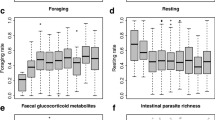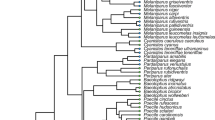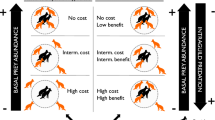Abstract
The main ecological factors that are hypothesized to explain the striking variation in the size of social groups among large herbivores are habitat structure, predation, and forage abundance and distribution; however, their relative roles in wild populations are not well understood. I combined analyses of ecological correlates of spatial variation in group size with analyses of individual behaviour in groups of different sizes to investigate factors maintaining variation in group size in an Indian antelope, the blackbuck Antilope cervicapra. I measured group size, habitat structure, forage, and the occurrence of predators in ten blackbuck populations, and, at a smaller spatial scale, within an intensively studied population. To examine the processes by which these ecological factors influence group size, I used behavioural observations and an experiment to estimate the shape of the relationship between group size and potential costs and benefits to individuals. Group size varied extensively both among and within populations. Analyses of spatial variation in group size suggested that both forage and habitat structure influence group size: large-scale, among-population variation in group size was primarily related to habitat structure, while small-scale, within-population variation was most closely related to forage abundance. Analyses of individual behaviour suggested that larger groups incur greater travel costs while foraging. However, individuals in larger groups appeared to experience greater benefits, namely the earlier detection of a “predator”, a reduction in vigilance, and an increase in the time spent feeding. Overall, these findings suggest that individuals in groups experience a trade-off between predation-related benefits and costs arising from feeding competition. Habitat structure and forage likely influence the nature of this trade-off; thus, variation in these ecological factors may maintain variation in group size. The role of predation pressure and other factors in explaining the remaining variation needs further exploration.




Similar content being viewed by others
References
Alexander RD (1974) The evolution of social behavior. Ann Rev Ecol Syst 5:325–383
Altmann J (1974) Observational study of behavior: sampling methods. Behaviour 49:227–267
Blumstein DT, Daniel JC (2002) Isolation from mammalian predators differentially affects two congeners. Behav Ecol 13:657–663
Bor NL (1960) The grasses of Burma, Ceylon, India and Pakistan. Pergamon, Oxford
Brashares JS, Arcese P (2002) Role of forage, habitat and predation in the behavioural plasticity of a small African antelope. J Anim Ecol 71:626–638
Byers JA (1998) Social adaptations and the ghosts of predators past. University of Chicago Press, Chicago, IL
Clutton-Brock TH, Guinness FE, Albon SD (1982) Red Deer: behavior and ecology of two sexes. Edinburgh University Press, Edinburgh, UK
Chapman CA, Wrangham RW, Chapman LJ (1995) Ecological constraints on group–size: an analysis of spider monkey and chimpanzee subgroups. Behav Ecol Sociobiol 36:59–70
Dehn MM (1990) Vigilance for predators: detection and dilution effects. Behav Ecol Sociobiol 26:337–342
Gerard JF Bideau E, Maublanc ML, Loisel P, Marchal C (2002) Herd size in large herbivores: encoded in the individual or emergent? Biol Bull 202:275–282
Hirth DH (1977) Social behaviour of white–tailed deer in relation to habitat. Wildl Monogr 53:1–55
Isvaran K (2005) Female grouping best predicts lekking in blackbuck (Antilope cervicapra). Behav Ecol Sociobiol 57:283–294
Jarman PJ (1974) The social organisation of antelope in relation to their ecology. Behaviour 48:215–267
Jarman PJ (1982) Prospects for interspecific comparison in sociobiology. In: King’s College Sociobiology Group (eds) Current problems in sociobiology. Cambridge University Press, Cambridge, pp 323–342
Jethva BD, Jhala YV (2004) Foraging ecology, economics and conservation of Indian wolves in the Bhal region of Gujarat, Western India. Biol Conserv 116:351–357
Jhala YV (1993) Predation on blackbuck by wolves in Velavadar National Park, Gujarat, India. Conserv Biol 7:874–881
Jhala YV (1997) Seasonal effects on the nutritional ecology of blackbuck Antilope cervicapra. J Appl Ecol 34:1348–1358
Kaufmann JH (1974) The ecology and evolution of social organization in the kangaroo family (Macropodidae). Am Zool 14:51–62
Krause J, Ruxton GD (2002) Living in groups. Oxford University Press, Oxford
Krebs CJ (1989) Ecological methodology. Harper Collins, New York
Lima SL, Zollner PA, Bednekoff PA (1999) Predation, scramble competition, and the vigilance group size effect in dark-eyed juncos (Junco hyemalis). Behav Ecol Sociobiol 46:110–116
Lingle S, Wilson WF (2001) Detection and avoidance of predators in white–tailed deer (Odocoileus virginianus) and mule deer (O. hemionus). Ethology 107:125–147
Lott DF (1991) Intraspecific variation in the social systems of wild vertebrates. Cambridge University Press, Cambridge
Maher CR (2000) Quantitative variation in ecological and hormonal variables correlates with spatial organization of pronghorn (Antilocapra americana) males. Behav Ecol Sociobiol 47:327–338
Mooring MS, Hart BL (1992) Animal grouping for protection from parasites: selfish herd and encounter–dilution effects. Behaviour 123:173–193
Mungall EC (1978) The Indian blackbuck antelope: a Texas view. Kleberg Studies in Natural Resources, College Station, TX
Mungall EC (1998) Bucks in the black: India versus Texas. Exot Wildl 8:1–3
Pinheiro JC, Bates DM (2000) Mixed-effects models in S and S-PLUS. Springer, New York
Pulliam HR, Caraco T (1984) Living in groups: is there an optimal group size? In: Krebs JR, Davies JB (eds) Behavioural ecology: an evolutionary approach. Sinauer Associates, Sunderland, MA, pp 122–147
R Development Core Team (2006) R: a language and environment for statistical computing. R Foundation for Statistical Computing, Vienna, Austria. ISBN 3-900051-07-0, http://www.R-project.org, cited 13 August 2007
Ranjitsinh MK (1989) The Indian blackbuck. Natraj Publishers, Dehradun, India
Sutherland WJ (1996) Mammals. In: Sutherland WJ (ed) Ecological census techniques: a handbook. Cambridge University Press, Cambridge, pp 260–278
Terborgh J, Janson CH (1986) The socioecology of primate groups. Ann Rev Ecol Syst 17:111–135
Thirgood S, Langbein J, Putman RJ (1999) Intraspecific variation in ungulate mating strategies: the case of the flexible fallow deer. Adv Study Behav 28:333–361
Underwood R (1982) Vigilance behaviour in grazing African antelopes. Behaviour 79:81–108
Walther FR (1972) Social grouping in Grant’s gazelle (Gazella granti) in the Serengeti National Park. Z Tierpschol 31:348–403
Wrangham RW, Gittleman JL, Chapman CA (1993) Constraints on group size in primates and carnivores: population density and day–range as assays of exploitation competition. Behav Ecol Sociobiol 32:199–209
Acknowledgments
I am very grateful to J. Brockmann, C. St Mary, Y.V. Jhala, C. Chapman, M. Sunquist, J. Eisenberg, B. Bolker, and S. Quader for helpful discussions and valuable comments on the manuscript; the University of Florida, the Animal Behaviour Society, the American Society for Mammalogists, and Sigma Xi for research funds; the Forest Departments of Andhra Pradesh, Gujarat, Maharashtra, Rajasthan, and Tamil Nadu in India for logistical support and kind permission to work in various protected areas; Y.V. Jhala, the USFWS-funded project entitled Conservation of the Indian Wolf, and the Wildlife Institute of India for considerable logistical help; K.V.R. Priyadarshini for help in the field; E. Mungall, W. Kyle and J. Kyle for extensive support with the Texas population; and J. Ganzhorn and three anonymous referees for valuable comments on the manuscript. This work complies with the current laws of the countries in which the work was carried out.
Author information
Authors and Affiliations
Corresponding author
Additional information
Communicated by Jörg Ganzhorn.
Electronic supplementary material
Below is the link to the electronic supplementary material.
Rights and permissions
About this article
Cite this article
Isvaran, K. Intraspecific variation in group size in the blackbuck antelope: the roles of habitat structure and forage at different spatial scales. Oecologia 154, 435–444 (2007). https://doi.org/10.1007/s00442-007-0840-x
Received:
Accepted:
Published:
Issue Date:
DOI: https://doi.org/10.1007/s00442-007-0840-x




